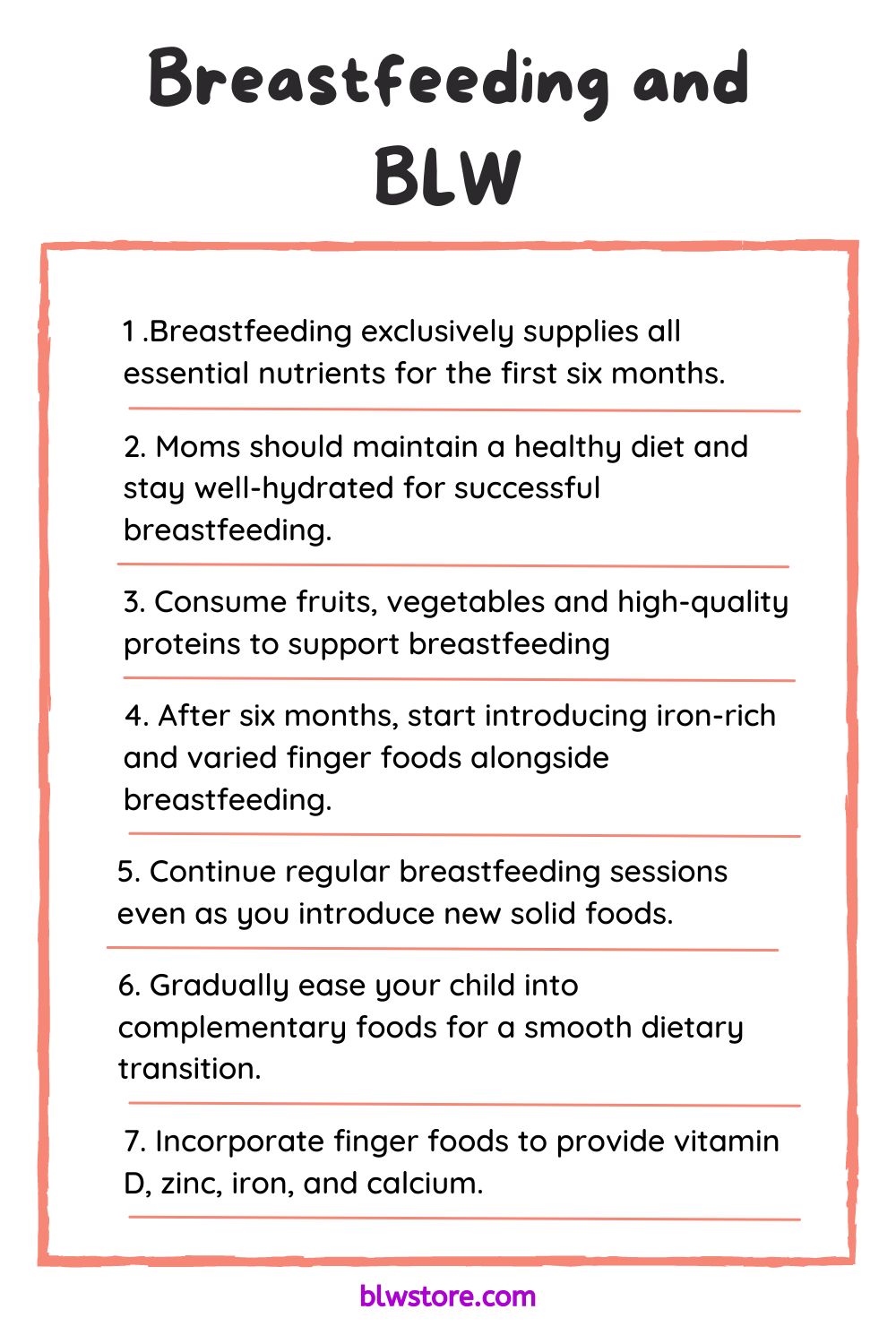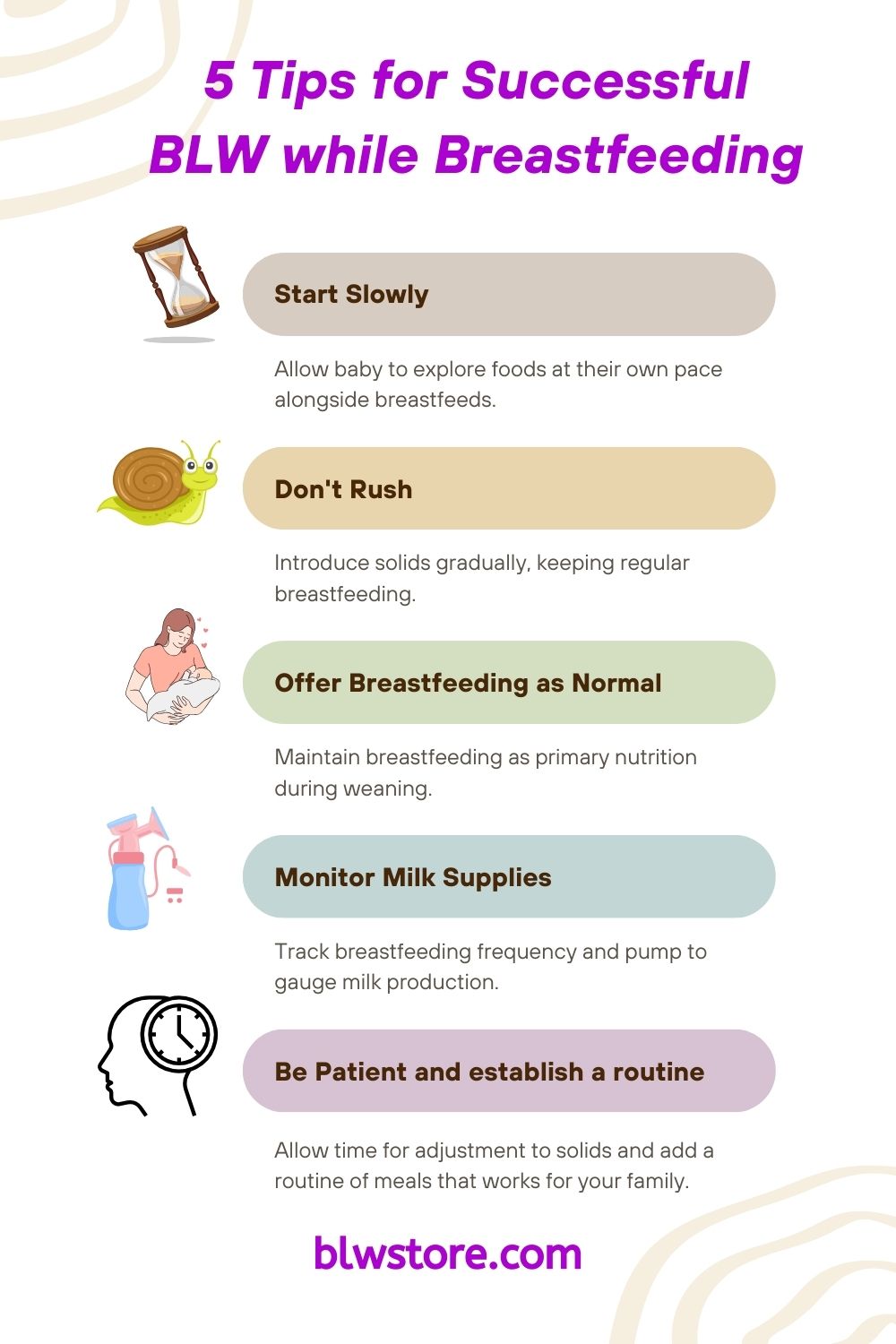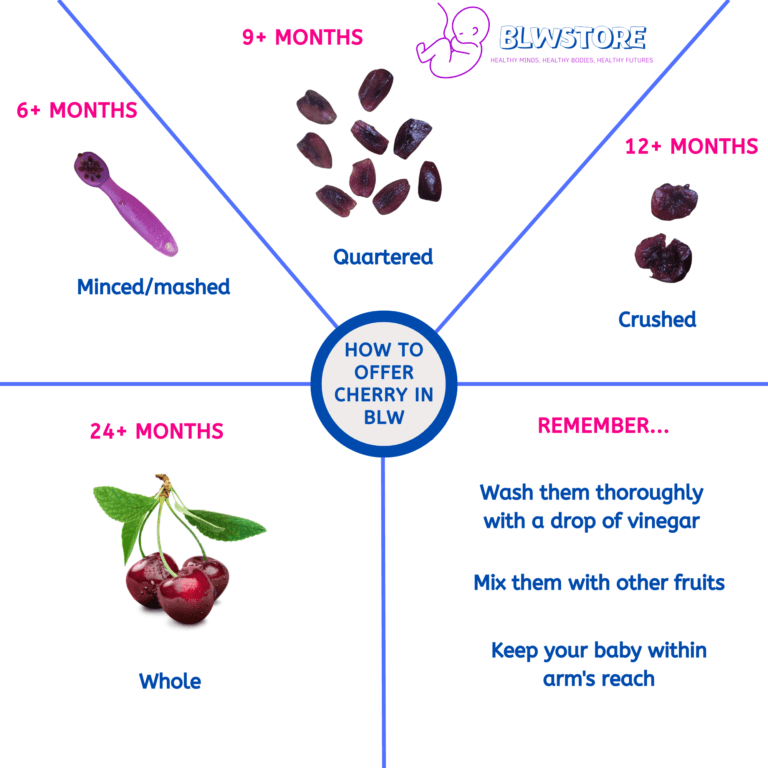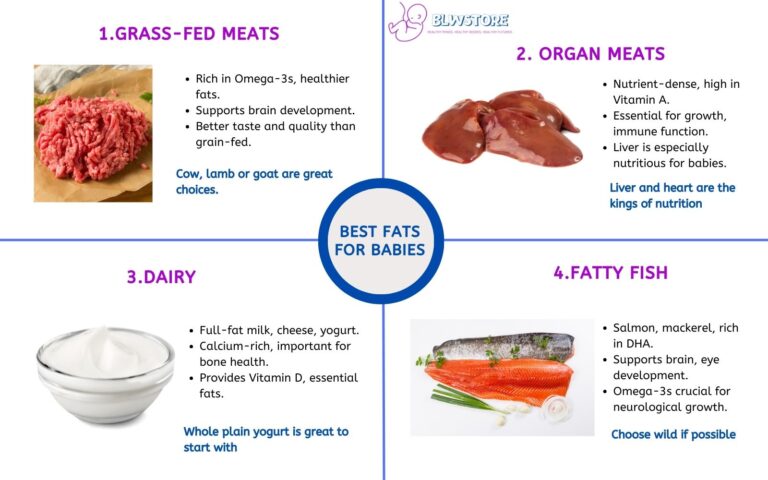
Are you a mom wondering if baby-led weaning and breastfeeding coexist harmoniously?
You’re not alone!
These two vital processes are crucial to your little one’s growth, development, and overall well-being.
We went through this same process with our son Pablo, and in this article, we share all those things we would have liked to know before.
Let’s get after it!
*Related: How to switch from breastmilk to formula
Key Takeaways
- Breastfeeding remains the priority until the 12-month mark, with BLW serving as complementary feeding.
- Gradually introduce solids while continuing breastfeeding on demand.
- Look for readiness signs: ability to sit up unsupported, loss of tongue-thrust reflex, and interest in food.
- Offer easy-to-eat options like ripe avocado or steamed vegetables, increasing the frequency of solids over time.
- Introduce new foods one at a time, monitoring for allergies or choking hazards.
- Complement breastfeeding with iron-rich and varied solid foods after six months.
- Breastfeed on demand, acknowledging its role in nutrition, bonding, and immune support.
- Adjust your approach based on your baby’s unique needs and preferences.
- Include your baby in main meals, encouraging interaction and offering food if they show interest.
- Offer breast milk before solid feedings in some cases to prevent your baby from filling up on solids and rejecting breast milk later.
Can Baby-Led Weaning And Breastfeeding Co-Exist?
They can indeed coexist, and BLW can even complement breast milk by supplying all the essential nutrients your baby requires during their first year.
Gradually introducing solid foods while maintaining regular breastfeeding sessions ensures your little one gets proper nutrition and develops feeding skills at a comfortable pace.
When combining BLW and breastfeeding, it’s vital to remember that breast milk or formula is still the primary source of calories and vital nutrients during your baby’s initial year.
Introducing solids too early could result in reduced milk intake, potentially leading to malnutrition or dehydration.
Therefore, adopting a slow and steady approach is crucial.
Don’t hesitate to consult with a healthcare provider to determine the appropriate amount of food to introduce at each meal while continuing to provide sufficient breastfeeds throughout the day.
Signs Your Baby Is Ready For Solid Foods
Introduce solids when your baby shows readiness signs, and gradually offer easy-to-eat finger foods alongside breastfeeding or formula, staying attentive to their needs and monitoring for allergies or choking hazards.
Before introducing solid foods to your baby, it’s crucial to ensure they are ready. Keep an eye out for these readiness signs:
- Ability to sit up unsupported
- Loss of the tongue-thrust reflex
- Showing interest in food
To make the experience more enjoyable, offer solids when your baby isn’t too hungry. Start with soft finger foods and follow these steps:
- Choose easy-to-eat options like ripe avocado or small pieces of steamed vegetables
- Begin by offering solids once a day, gradually increasing frequency as your baby becomes comfortable with self-feeding
- Continue breastfeeding or offering formula milk alongside solid foods to ensure adequate nutrition
Keep these essential tips in mind as you embark on the journey of combining breastfeeding and baby-led weaning:
- Follow recommended guidelines for feeding milestones
- Introduce new foods one at a time, monitoring for allergies or choking hazards
- Trust your instincts as a parent when managing both breastfeeding and BLW
Remember, balancing both methods can be done successfully with patience and attentiveness to your baby’s needs.
Basics of Introducing Solids while Breastfeeding

Maintain a healthy diet for successful breastfeeding, and after six months, gradually introduce iron-rich and varied finger foods alongside breastfeeding to provide essential nutrients and support your baby’s developing digestive system.
During the first six months, breastfeeding supplies all the necessary nutrients for your baby’s growth and development.
It’s crucial for moms to:
Maintain a healthy diet
Stay well-hydrated
Consume nutrient-rich foods such as fruits, vegetables, lean proteins, and whole grains to support breastfeeding
After six months, as babies start transitioning to solid foods, remember to:
Introduce iron-rich and varied foods to complement breastfeeding
Continue regular breastfeeding sessions
Gradually ease your child into new types of complementary foods for a smooth transition
Incorporating a mix of finger foods alongside breastfeeding can:
Provide essential nutrients like vitamin D, zinc, iron, and calcium
Support the developing digestive system
Help your baby adjust to different textures over time
Do you Need to Reduce feedings after introducing solids?
No, you must continue offering breastfeeds on demand during Baby-Led Weaning, allowing your baby to control food consumption while meeting their nutritional requirements and supporting the mother-baby bond.
Breastmilk plays a vital role in your baby’s nutrition, even as they begin to transition to solid foods through Baby-Led Weaning (BLW).
The amount of breastmilk or formula your baby needs varies depending on their age, weight, and appetite.
As your baby starts to eat more solid foods during BLW, it’s crucial to:
- Continue offering breastfeeds on-demand
- Recognize that breastfeeding provides essential nutrition, supports mother-baby bonding, and boosts the immune system
When combining breastfeeding and BLW, it’s best to:
- Follow your baby’s lead regarding when they want a feed or when they are full from solids
- Understand that this approach allows infants control over food consumption while still meeting their nutritional requirements through breastfeeding until the end of weaning
5 Tips For Successful Baby-Led Weaning While Breastfeeding

1. Start Slowly
- Give your baby plenty of time to explore and experiment with different foods at their own pace
- Offer breastfeeds as normal alongside solid foods, ensuring adequate nutrition
- Be patient and adjust your approach based on your baby’s unique needs and preferences
2. Don’t Rush
- Take your time and don’t feel pressured to stop breastfeeding before your child is ready for solids
- Gradually introduce solid foods while maintaining a regular breastfeeding schedule
3. Offer breastfeeding as normal
- Continue breastfeeding as the primary source of nutrition during weaning
- Allow your baby to self-attach during feeding for a smoother transition
4. Monitor Milk Supplies
Pay attention to how often and how much your baby is breastfeeding
Pump after feedings to see how much milk you’re producing
Adjust breastfeeding or pumping frequency if needed
5. Be Patient
Give your baby time to adjust to the new feeding method
Monitor your milk supply while introducing solid foods
Offer breastmilk before solid foods or nurse more frequently if needed
BLW And Breastfeeding Schedule Example
7:00 AM – Wake Up and Breastfeed
- Begin the day by breastfeeding your baby on demand.
8:00 AM – Breakfast with Family
Avocado slices
- Steamed carrot sticks
- Offer water in an open cup
Breastfeed on demand
12:30 PM – Lunch with Family
- Steamed broccoli florets
- Cooked chicken
- Sweet potato wedges (baked or steamed)
- Offer water in an open cup
Breastfeed on demand
3:30 PM – Afternoon Snack
- Banana or ripe pear slices
- Cooked green beans
- Whole grain toast fingers
- Offer water in an open cup
Breastfeed on demand
6:00 PM – Dinner with Family
- Lentil patties
- Steamed zucchini
- Offer water in an open cup
Breastfeed on demand
7:30 PM – Bedtime Breastfeed
- End the day with a breastfeeding session before putting your baby to bed.
Remember that every baby is different, and this schedule may need to be adjusted to fit your baby’s unique needs and preferences. Feel free to add or change the BLW foods as needed.
Last Words and Tips
Drawing from personal experience, Maria, who continues to breastfeed our 2-and-a-half-year-old son Pablo while practicing BLW since he was six months old, shares two valuable lessons:
Pay attention to and respect your baby’s hunger cues. Instead of forcing your baby to adapt, be flexible and adjust your approach to accommodate their needs.
Establish a routine where your baby joins you during main meals, even if they’re not hungry. Encourage interaction and conversation, and offer food if they express interest. Eating similar or the same foods as your baby can also be helpful, as it reinforces the idea that you are sharing the same meal.
So go ahead, embrace the journey, and delight in watching your little one grow into a happy, healthy eater!
We’re Maria and Alberto, a married couple and educators who are nutrition enthusiasts. Even before we had kids, we were already crazy about nutrition.
We’d read scientific articles, watch videos from nutritionists, and spend hours listening to nutrition podcasts.
Today, we continue doing this, but in a different way, as we’ve learned to sift through the noise and trends. Nutrition, like any other field of knowledge, the more you read and learn, the more you develop a comprehensive understanding of reality, and that’s what has happened to us.
Before having our first child, we focused on learning everything we could about child nutrition, using the same techniques we had already employed, backed by our extensive knowledge in nutrition.
Our mission is to help other parents with their children’s nutrition, to help them become the best versions of themselves.
If we are what we eat and drink, which is absolutely true, let’s do it right!







